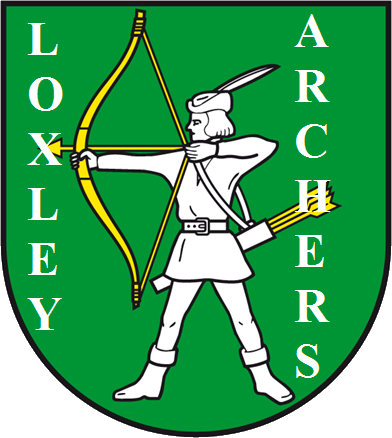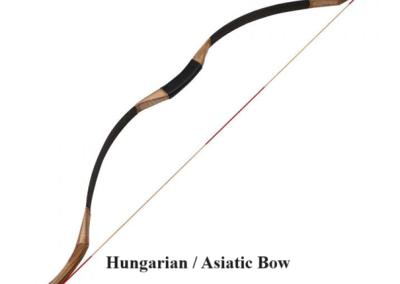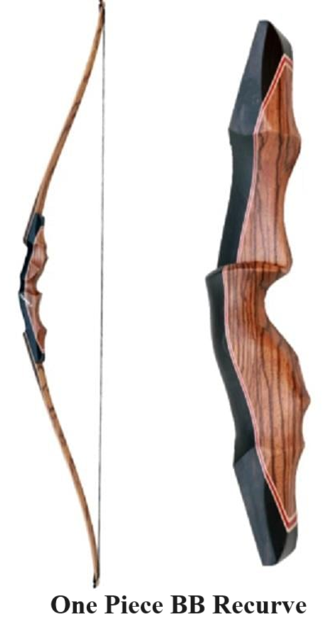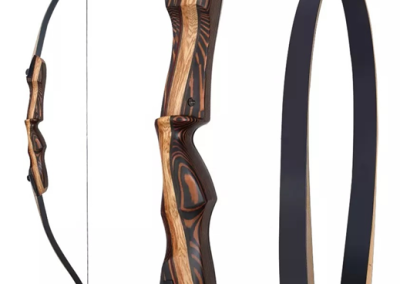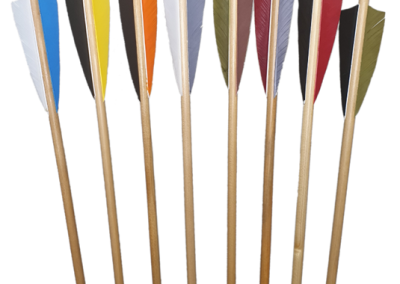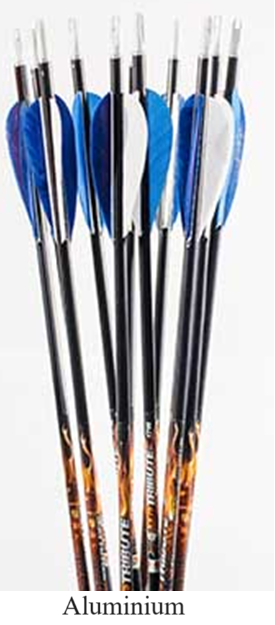
Club Information
Office Bearers
President: Peter Starr
Vice President: Gaynor Starr
Treasurer: Gaynor Starr
Secretary: Gaynor Starr
Web Design & Master: James Cassidy
TAA State Rep: Peter Starr
TAA State Coach: Peter Starr
Traditional Archery Australia Coach: Peter Starr
School Archery coordiator: Peter Starr
(Working with Children Card Number: 943363069) – You can verify the status of this here.
We cater for all beginners from 10 to 80+
Basic Archery Courses:
We have a qualified Traditional Archery Australia club coach who conducts Basic Archery Courses which are run periodically throughout the year. These have been highly successful and are a great way for beginners to learn about archery in a safe environment, become familiar with our club and make new friends. Courses numbers are limited. Places will be allocated on a first-come-first-in basis. The cost of the course includes instruction, insurance and equipment.
Times and Details Beginners Program:
Beginners courses are run on Saturdays (dates supplied upon inquiry). The lower age limit is 10 years old but under 16 years old must be accompanied by an adult. There is no upper age limit. All archers must wear closed in shoes and should wear close-fitting shirts or blouses (loose clothing is not advised). All participants must register as Temporary Players with Traditional Archery Australia and thus receive Temporary Public Liability insurance cover. Temporary player registration provides no other benefits and is limited to the duration of the beginner’s course, after which you are expected to join in the club.
For further information or to register for the next course please Get In Touch

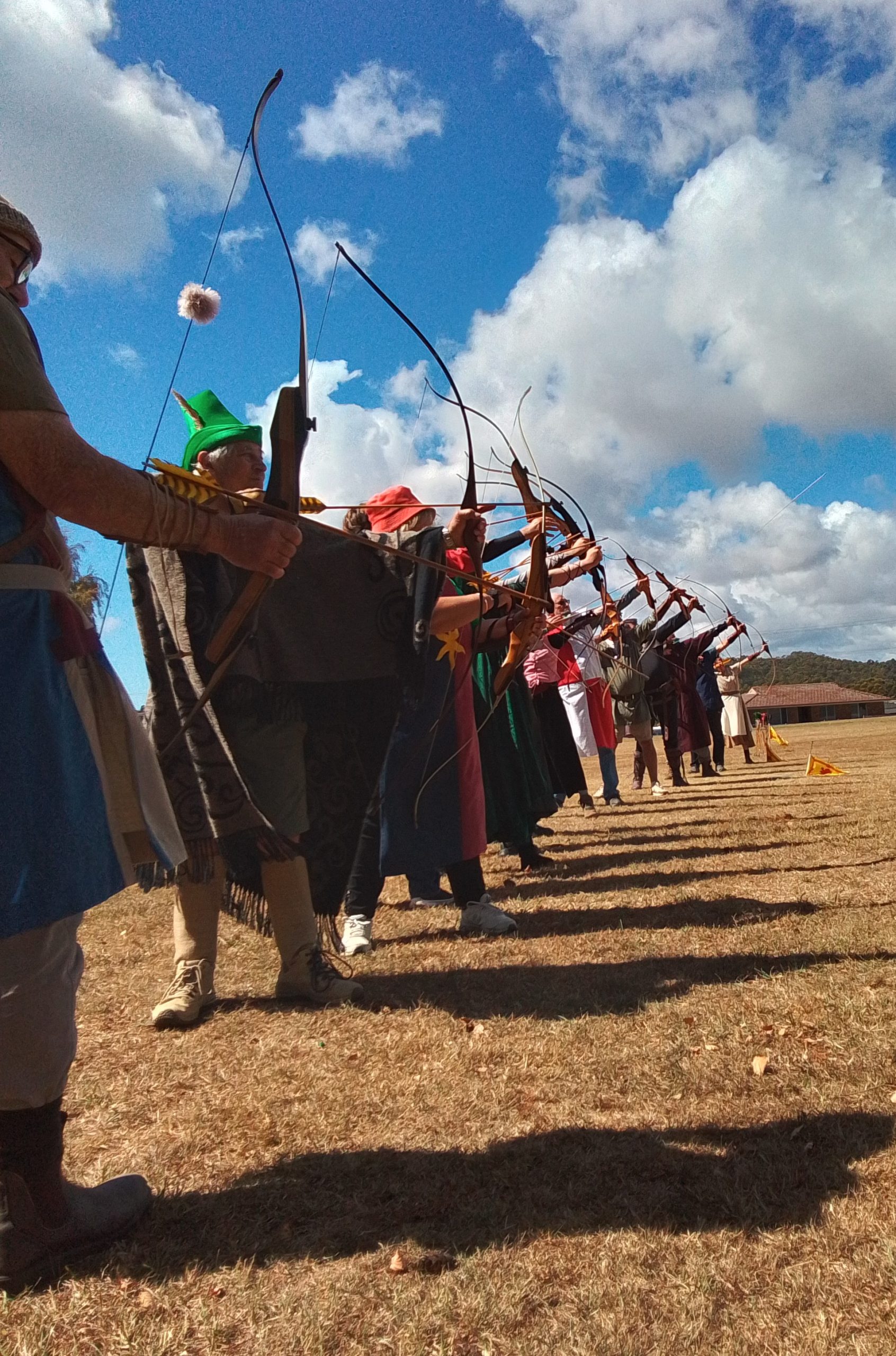
Range Rules & Equipment
Shooting Technique
Equipment
- Bows: Longbow, Horse bow, Barebow Recurve.
- No compound bows are allowed.
- Bows are to be made completely of timber – no metal risers.
- A bow may be Longbow, Horse Bow or Barebow Recurve provided it subscribes to the accepted principle and meaning of the word ‘bow’ as used in target archery; i.e. an instrument consisting of a handle (grip), riser and two flexible limbs each ending in a tip with a string nock.
- Takedown Recurve bows to have a wooden handle (grip) riser.
- No modern spring/flipper rests.
- No Plunger buttons are allowed.
- The use of simple rests is allowed such as a simple one-piece plastic or non-adjustable rest, the use of the shelf in a cut out window is also allowed.
- No stabilisers, clickers, or modern string release devices are allowed.
- No sight or marks on the bow that help aiming are allowed. Any marks, blemishes or laminations that can be used to help with aiming are not permitted
- Face or string walking is not permitted.
- A ground marker is not permitted.
Arrows
Arrows
- Wood and Aluminium arrows are permitted.Fletching shall consist of feathers only.Carbon and Carbon/Aluminium arrows are NOT permitted.
Finger Position
-
- Arrows may be shot using the Mediterranean release (one finger above and two fingers below the arrow) three fingers below the arrow (within 2 mm) or a thumb ring provided it does not incorporate any device to hold, draw and release the string. Face or string walking is not permitted.
Finger & Hand Protection
-
-
- Finger protection in the form of finger stalls or tips, glove, or shooting tab or tape (plaster) to draw, hold back and release the string is permitted.
-
Collecting Arrows
- Walk forward to collect the arrows, never run.
- Always walk up to the side of the target butt so as to not to accidentally walk into the rear of the arrows lodged in the target.
- One person at a time should withdraw their arrows from the target.
- When withdrawing arrows from the target make sure no one is standing in front of the target or in the way of the withdrawn arrows. Withdrawing the arrows may require some force and the arrows may come out suddenly from the target butt and the rear end of the arrow could hit someone standing in front of the target.
- If searching for arrows behind the target at least one member of a group must remain standing in front of the target while others are searching.
- When carrying arrows always hold them to the side.
- After each end everyone must return to the shooting line and the range must be checked to make sure no one is behind the target butts or in the safety zone before the signal to commence shooting is given.
Shooting
Shooting
- A bow must not be loaded with an arrow unless standing on the Shooting Line with one foot over the Line and the signal to start shooting has been given.
- A loaded bow must only be pointed at the assigned target. It must not be pointed at another person.
- An arrow must not be shot straight up into the air.
- A cracked or bent arrow must never be shot.
- A person must never stand forward of an archer about to shoot.
- If an arrow or part of equipment is dropped in front of the shooting line while shooting is in progress it can only be picked up after shooting has stopped.
- When each student has finished shooting their arrows they should stand back from the shooting line so the instructor can clearly see that they have finished.
- Only when everyone has finished shooting will the signal to move forward to collect the arrows be given.
Collecting Arrows
-
Collecting Arrows
- Walk forward to collect the arrows, never run.
- Always walk up to the side of the target butt so as to not to accidentally walk into the rear of the arrows lodged in the target.
- One person at a time should withdraw their arrows from the target.
- When withdrawing arrows from the target make sure no one is standing in front of the target or in the way of the withdrawn arrows. Withdrawing the arrows may require some force and the arrows may come out suddenly from the target butt and the rear end of the arrow could hit someone standing in front of the target.
- If searching for arrows behind the target at least one member of a group must remain standing in front of the target while others are searching.
- When carrying arrows always hold them to the side.
- After each end everyone must return to the shooting line and the range must be checked to make sure no one is behind the target butts or in the safety zone before the signal to commence shooting is given.
Your Title Goes Here
Safety
- Only string a bow using a recommended safe method.
- Never draw and release a bow without an arrow on the string; this is known as “Dry-Firing” the bow, and could result in damage to the bow limbs, a broken string, or possible injury to the archer.
- Wear tight fitting clothes and closed-in footwear: not thongs or sandals & tie back long hair.
- Always wear an arm-guard to prevent injury from the bowstring during shooting.
- All shoots are under the direct supervision of the FIELD CAPTAIN whose duties include the complete control of shooting.
- Control is achieved by use of a whistle or verbal commands.
- 1 Blast archers to the line and commence shooting.
- 2 Blasts stop shooting collect arrows.
- 3 or more Blasts emergency stop shooting immediately and if at full draw let down.
- A bow must not be loaded with an arrow unless standing on the Shooting Line and the signal to start shooting has been given.
- A loaded bow must only be pointed at the assigned target. It must not be pointed at another person.
- Do not turn your bow horizontally on the shooting line as it may interfere with other archers.
- Do not draw and shoot an arrow while people are in front of the shooting line.
- lf a bow or arrow falls over the shooting line the archer should wait until their fellow archers on either side have finished shooting before retrieving the equipment and then only if it has fallen within bow reach from the shooting position.
- An arrow must not be shot straight up into the air.
- A cracked or bent arrow must never be shot.
- A person must never stand forward of an archer about to shoot.
- When each archer has finished shooting their arrows they should stand at least 3 paces back from the shooting line so the instructor can clearly see that they have finished.
- Only when everyone has finished shooting will the signal to move forward to collect the arrows be given.

Stance
- Put your feet on both sides of the shooting line.
- Your feet should be about a shoulder's width apart.
- A square or slightly open stance is best
- Stand up straight and relaxed.
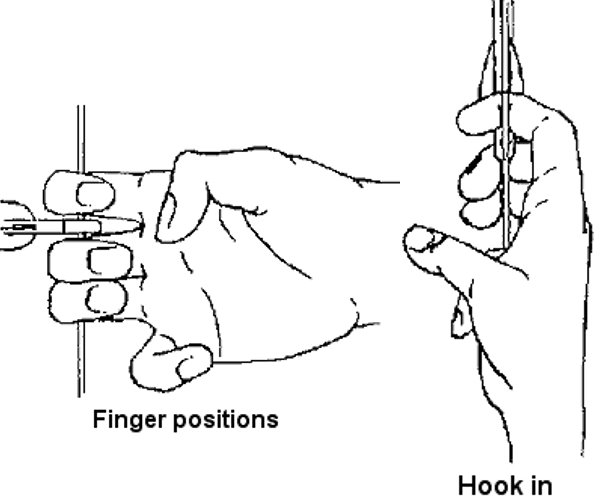
Fingers
- Place your fingers on the string with your index finger above the nock and middle and ring finger under the nock
- Hook the string between first and second joint.
- Make sure to maintain a deep hook.
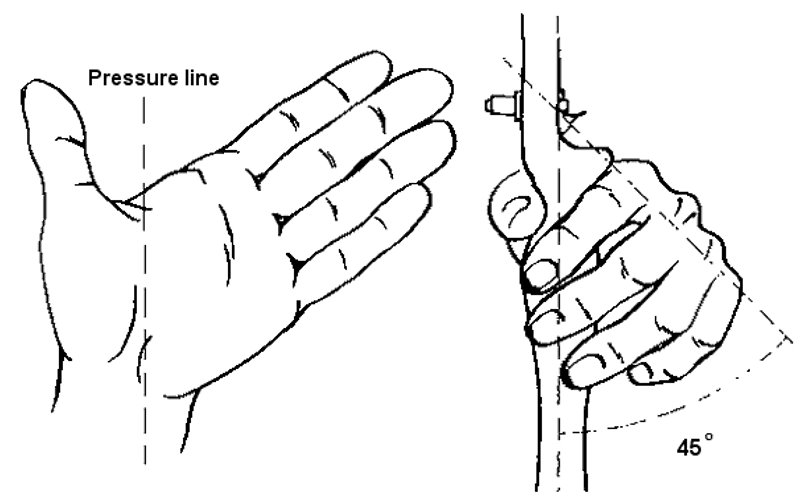
Bowhand
- Hold the bow loosely with the pressure of the bow distributed along the pressure line.
- Relax your fingers. The back of your hand should make an angle of 45 degrees.
- The tips of thumb and index finger are may touch each other but the hand must remain relaxed.

Bowarm
- Bring the bow arm to shoulder height
- Keep your bow shoulder down as low as possible.
- Rotate your elbow away from the string

Draw
- Keep your bow arm level.
- Draw the string along the bow arm and down towards the bottom of your neck.
- Use your back muscles, bringing the elbow around and moving the shoulder blades towards each other.
- Keep both shoulders as low as possible.
- Keep your head upright.
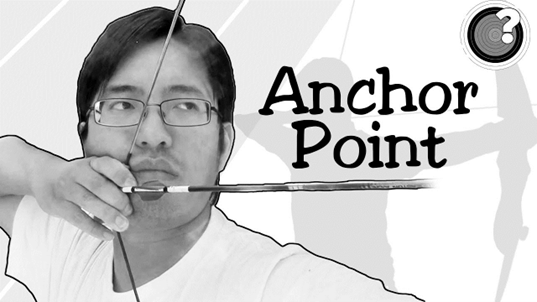
Anchoring
- Bring your hand up to seat your index finger firmly under your chin.
- Keep your teeth together.
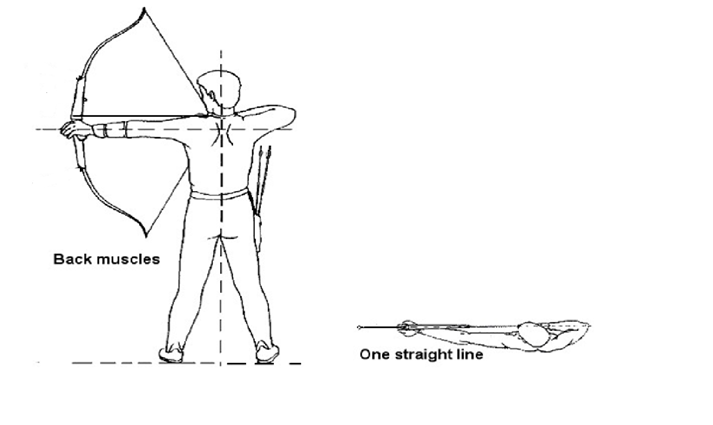
Holding
- Keep the back muscles under tension.
- Relax the shoulder muscles.
- Bow hand, draw hand and elbow should form a straight line.
- Keep both shoulders as low as possible.
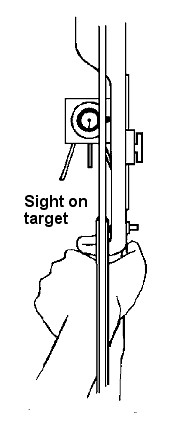
Aim
- Keep both eyes open.
- Place the sight on the target and allow it to float gently around the centre.
- Keep the string a little left of the sight.

Release
- Keep squeezing the shoulder blades towards each other.
- Relax the fingers of the draw hand. Do not try to open your hand.
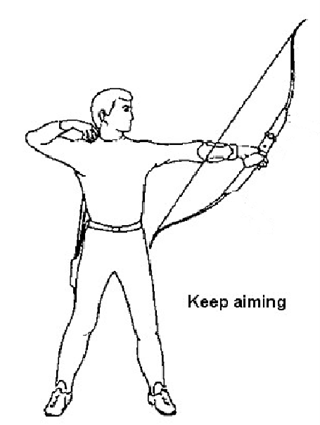
Follow Through
- The draw hand should move back naturally to near or behind your ear.
- Hold your stance until after the arrow hits the target.
Shooting Technique
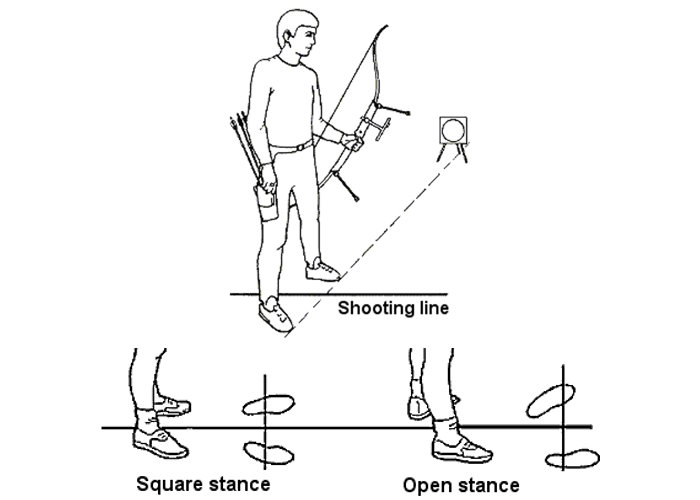
Stance
- Put your feet on both sides of the shooting line.
- Your feet should be about a shoulder's width apart.
- A square or slightly open stance is best
- Stand up straight and relaxed.

Fingers
- Place your fingers on the string with your index finger above the nock and middle and ring finger under the nock
- Hook the string between first and second joint.
- Make sure to maintain a deep hook.

Bowhand
- Hold the bow loosely with the pressure of the bow distributed along the pressure line.
- Relax your fingers. The back of your hand should make an angle of 45 degrees.
- The tips of thumb and index finger are may touch each other but the hand must remain relaxed.
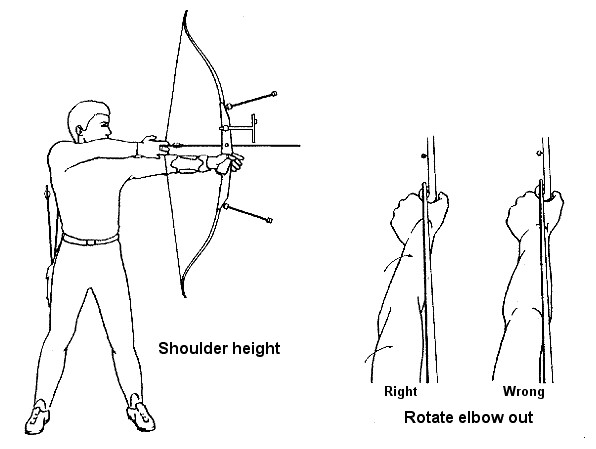
Bowarm
- Bring the bow arm to shoulder height
- Keep your bow shoulder down as low as possible.
- Rotate your elbow away from the string

Draw
- Keep your bow arm level.
- Draw the string along the bow arm and down towards the bottom of your neck.
- Use your back muscles, bringing the elbow around and moving the shoulder blades towards each other.
- Keep both shoulders as low as possible.
- Keep your head upright.
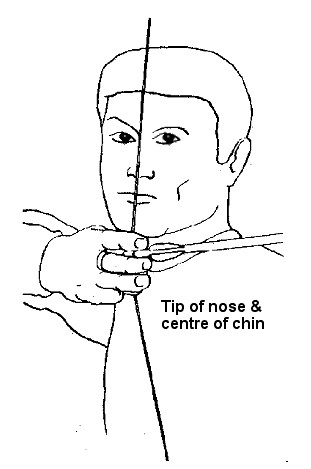
Anchoring
- Bring your hand up to seat your index finger firmly under your chin.
- The string should touch the middle of the chin and the tip of the nose.
- Keep your teeth together.

Holding
- Keep the back muscles under tension.
- Relax the shoulder muscles.
- Bow hand, draw hand and elbow should form a straight line.
- Keep both shoulders as low as possible.

Aim
- Keep both eyes open.
- Place the sight on the target and allow it to float gently around the centre.
- Keep the string a little left of the sight.

Release
- Keep squeezing the shoulder blades towards each other.
- Relax the fingers of the draw hand. Do not try to open your hand.

Follow Through
- The draw hand should move back naturally to near or behind your ear.
- Hold your stance until after the arrow hits the target.
